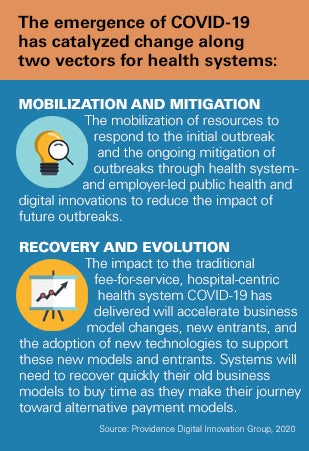
Environmental Trends
3 Digital Strategic Priorities for the Next Normal
Anticipating changing business and workforce models in health care
Editor’s note:This item originally ran in the AHA Center for Health Innovation Market Scan newsletter on September 29, 2020. Market Scan provides insights and analysis on the field’s latest developments in health care disruption, transformation and innovation. To subscribe, please click here.
It can be difficult to assess precisely where we are in the life of the COVID-19 pandemic, let alone what to expect on the road to the next normal. A recent report, “Journey Toward the Next Normal,” from the Providence Digital Innovation Group provides some answers and examines the role that technology and digital health will play in achieving this transformation.
The report, based on the nonprofit health system’s experience and interviews with more than 100 health system, technology and innovation leaders, notes that the biggest factors in creating the next normal will involve changing business models and accelerating a health system’s ability to manage risk. One reason: Health systems that have sponsored health plans and extensive risk contracts have seen a smaller impact from COVID-19 in the short term while those who depend on commercially insured procedures to cross-subsidize Medicare and Medicaid have seen deeper losses.

All health systems will start to feel the impact of declining commercial insured membership as the recession, at whatever duration, takes hold. That process has already begun. A recently released Robert Wood Johnson Foundation report shows that over the summer more than 3 million Americans lost employer-sponsored health coverage and 2 million became uninsured.
Facing this reality, health care providers will have to make major changes in care models, cost structure and the use of digital technology to recover.
3 Big Impacts and Outcomes to Anticipate
- Distributed care and virtual health. The surge in virtual care brought on by COVID-19 will begin an era of decentralization powered by virtual modalities and enablers of care in the home and outside health care facilities. This will require new payment, regulatory and operating models and a frictionless, connected experience to maintain and sustain digital adoption and distributed care models among patients and providers. This surge will have impacts across the care continuum ranging from hospital at home to remote patient monitoring, outpatient and nonurgent virtual care, and virtual chronic disease management.
- Industry consolidation. Consolidation of assets, driven primarily by health plans and private equity, will impact the standardization of technology platforms related to integrated care systems, disrupting the related referral channels. Providers will need to focus on integration and referral management to ensure that business recovery and long-term business model goals can be achieved with this form of disruption.
- New workforce and facility models. Health care organizations have struggled to flex their workforce and facilities to respond to COVID-19, indicating a new need for flexibility that allows their workforce and facility adaptation across geographies and care modalities, including virtual, based on clinical need.
The Providence Digital Innovation Group has posted other reports online in its COVID-19 Digital Insights Series on new workforce and facility models, distributed care and digital health acceleration, managing trust and safety and other topics.
